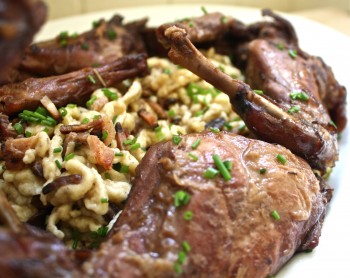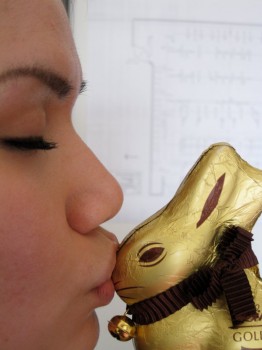Why this aversion to rabbit, I ask?
For those folks who have kept rabbits as pets, the aversion is understandable, though why anyone would want one in their home is beyond me. They serve no practical domestic purpose of which I am aware. They don't do tricks (I stand corrected here. Some of them do do tricks). They are more than often pests-- just look at what happened to Australia.
Lambs are cute, too, and provide wool for sweaters and socks but we don't seem to have much of a problem eating them. Rabbits are turned into coats that only hookers seem to wear, so why do some people cry when they see them offered on a restaurant menu but don't seem to bat an eye when they read the word "lamb"?
Why would anyone else (apart from vegetarians) be averse to eating rabbit moreso than other animal flesh? Did they suffer through enough rabbit stews during the Great Depression and World War rationing? Is the Easter Bunny and his promises of candy to blame? Have we been brainwashed or bribed with enough sugar into believing the consumption of rabbit flesh is a crime against nature, but that somehow eating other adorable-looking animals is perfectly acceptable?
Or does it have something to do with Bugs Bunny? I've here people at my tables reference him (ad nauseum) and giggle after I mention our rabbit dish, but never do they mention Daffy Duck or Porky Pig or Foghorn Leghorn when they order their dishes of duck or pork or chicken, respectively.
Cute food, it seems, is wholly subjective.
The same people who profess horror at the thought of eating real rabbits do not seem to have a problem eating chocolate or marshmallow likenesses of them. Much thought is often given to which part of the delicacy should be eaten first-- the tail? the ears? It seems to me that it is one, short step from eating an effigy of something to eating the thing itself. (Okay, that's a bit of a stretch, but it's something else to think about. I mean, do vegetarians eat marshmallow peeps? It's just a question.)
I made that leap myself years ago. If you have no issues with consuming animal protein, I invite you now to join me in a little rabbit stew.
And while we're eating, perhaps you could next explain to me why it is that most people recoil in horror at the site of a rat minding its own business, yet squeal with delight whenever a squirrel rips a salted peanut out of their hand?
Oh, right. It's all about cute.
Hasenpfeffer with Bacon-Chive Spätzle

When researching Hasenpfeffer, I discovered that there seemed to be no two recipes that were alike. This doesn't surprise me given the fact that, for most of its history, Germany was little more than a patchwork of kingdoms, principalities, Margraves, and Palatinates. What on earth would lead me to think that Hanoverians, Prussians, Pomeranians, and Bavarians would ever unite over a rabbit dish?
Hasenpfeffer is a stew made from bits of rabbit or hare. Hasen is the German word for rabbit and, of course, explains why there is rabbit in the recipe. Pfeffer, which means "pepper" in the same language, refers to the little bits and pieces of rabbit which can be found in the stew and perhaps explains why there isn't a preponderance of actual pepper in the recipe. It's there alright, but not enough to merit a co-starring role.
I'll just chalk it up to my inability to grasp the nuances of the German language.
Serves 6 to 8 hungry people who are unafraid of eating cute creatures.
This is my own version-- a culling of others, with a few added touches of my own. I will never claim this recipe's authenticity as echt German but, being from Anaheim, which was (unsurprisingly) settled by Germans, I think it might be like some sort of birthright or something to lay claim to my own hasenpfeffer dish. It is a forgiving recipe, allowing for increases in amounts of the various ingredients, according to one's own tastes.
Ingredients:
Part One: The Marinade
2 rabbits (about 4 pounds), skinned and gutted and otherwise dressed.
1 1/4 cups dry red wine
3 cloves chopped garlic
about 1/2 cup shallots, thinly sliced
1 tablespoon dijon mustard
1 tablespoon kosher salt
Part Two: Stewing The Rabbit
1/3 cup all-purpose flour, for dusting the rabbit
1 to 1 1/4 cups water
1/2 pound bacon (I used Black Forest bacon because it just seemed to make sense.)
1 tablespoon red currant jelly
1/4 teaspoon dried rosemary, crushed
1/4 teaspoon dried thyme
1/4 teaspoon black peppercorns, crushed
1 bay leaf
A splash or two of apple cider vinegar to taste
Salt and more pepper to taste
A slurry of equal parts flour and water, in case the stew is not thick enough
Part Three: The Spätzle
1 cup all-purpose flour
1 teaspoon kosher salt
1/2 teaspoon ground pepper
1/2 teaspoon freshly ground nutmeg (pre-ground works well, too, but not quite as well)
2 large eggs, preferably at room temperature
1/4 cup milk
As much fresh chive as you like, or 2-to-3 tablespoons, chopped
Preparation:
1. In a bowl large enough to accommodate all your rabbit meat, combine red wine, salt, shallots, garlic, and mustard. Whisk to combine well. Rinse rabbit meat. Separate the legs-- hind and fore-- from the rabbits' bodies, then divide the carcasses into three or four pieces. Add rabbit to the wine mixture, cover and refrigerate. This can sit in your ice box for up to three days. I recommend letting it sit at least over night.
2. When you are ready to make your hasenpfeffer, fry up your bacon on a medium-high heat until crisp in the largest frying pan, Dutch Oven, or otherwise heavy-bottomed skillet you've got. Patience in bacon-frying rewards you with more rendered fat, so go gently. When bacon is done, remove, drain on paper towels, and chop into bits. Leave the bacon fat in the pan.
3. In a large plate or wide, shallow bowl, put your flour. Remove rabbit pieces from marinade, pat dry, and dredge in flour, shaking off any excess. Working in two batches, brown the rabbit. If you don't have enough bacon fat to evenly coat the bottom of your pan, simply add enough olive oil to do so (I told you this was a forgiving recipe.). Strain the marinade, so that you might temporarily liberate the shallots.
4. When all the rabbit has been browned, remove to a plate then add the shallots to the pan. Sauté for three to four minutes to deepen their flavor (they will have virtually disintegrated by the time your stew is finished, so don't worry about their looks). Add your wine marinate and water to the pan and bring to a boil. Now add your thyme, rosemary, crushed black pepper, and red currant preserves.
5. Add your rabbit pieces to the pan and one half of the chopped bacon. Return to a boil and then back down to a simmer. Cover and let simmer for about 1 1/2 hours, or until the meat looks as if it might start falling of the bone, which is pretty much what you want to happen. If you have no proper lid for your largest pan, as I do not, cover well with aluminum foil, or aluminium foil, if you are preparing this dish in Canada.
6. Now here comes the exciting part-- the spätzle, which means "little sparrow" in Swabian, in case you didn't know. In a large bowl, combine flour, salt, nutmeg, and pepper. In a separate bowl whisk together the milk and eggs. Make a well in the center of the dry ingredients and gently pour in the egg-milk mixture. Draw in flour from the sides of the well and combine until the dough is smooth and think. Let rest for 10 to fifteen minutes.
7. Bring about 3 quarts of lightly salted water to a boil in a large, wide pot. Reduce to a simmer. To form the spätzle (or, if you prefer, spaetzle), hold either a spoon or colander with large holes over the simmering water (of course, if you had a spätzle press, you'd be using that) and push the dough through the holes with a spatula. Best to do this in 4 to 5 batches-- noodles do not take well to over-crowding. Cook each batch for 3 to 4 minutes, or until they float to the surface, as though they were, in fact, little sparrows that had been forcibly drowned and had finally given up on life. Remove the dead sparrows to a colander and let drain.
8. When the stew is ready, remove the rabbit pieces to a warm platter, placing said platter in a warm oven. If the remaining sauce is not as thick as you would like (read: gravy-like consistency) at a little flour/water slurry to firm things up, cooking long enough, of course, to properly cook the flour.
9. At this point, you could either strain the sauce through a sieve to have a smooth sauce, or leave it as is. I vote as is-- why get rid of all that bacon and lumpy goodness? It is entirely up to you.
10. Now-- and finally-- in a separate pan, add your spätzle, and remaining bacon, along with about a half cup (or more to taste) of your rabbit sauce. Toss gently and heat through. Remove the spätzle to the center of a large serving platter and garnish liberally with chopped chives. Arrange the rabbit pieces around the spätzle, pour over as much of the sauce as you like and some more chives, should you find the need for more color.
Proudly serve your guests this platter of dead bunnies and little sparrows with a side of steamed, whole baby carrots. To young children. While they are watching Warner Bros. cartoons. One mights as well make as grand a statement as one can.

